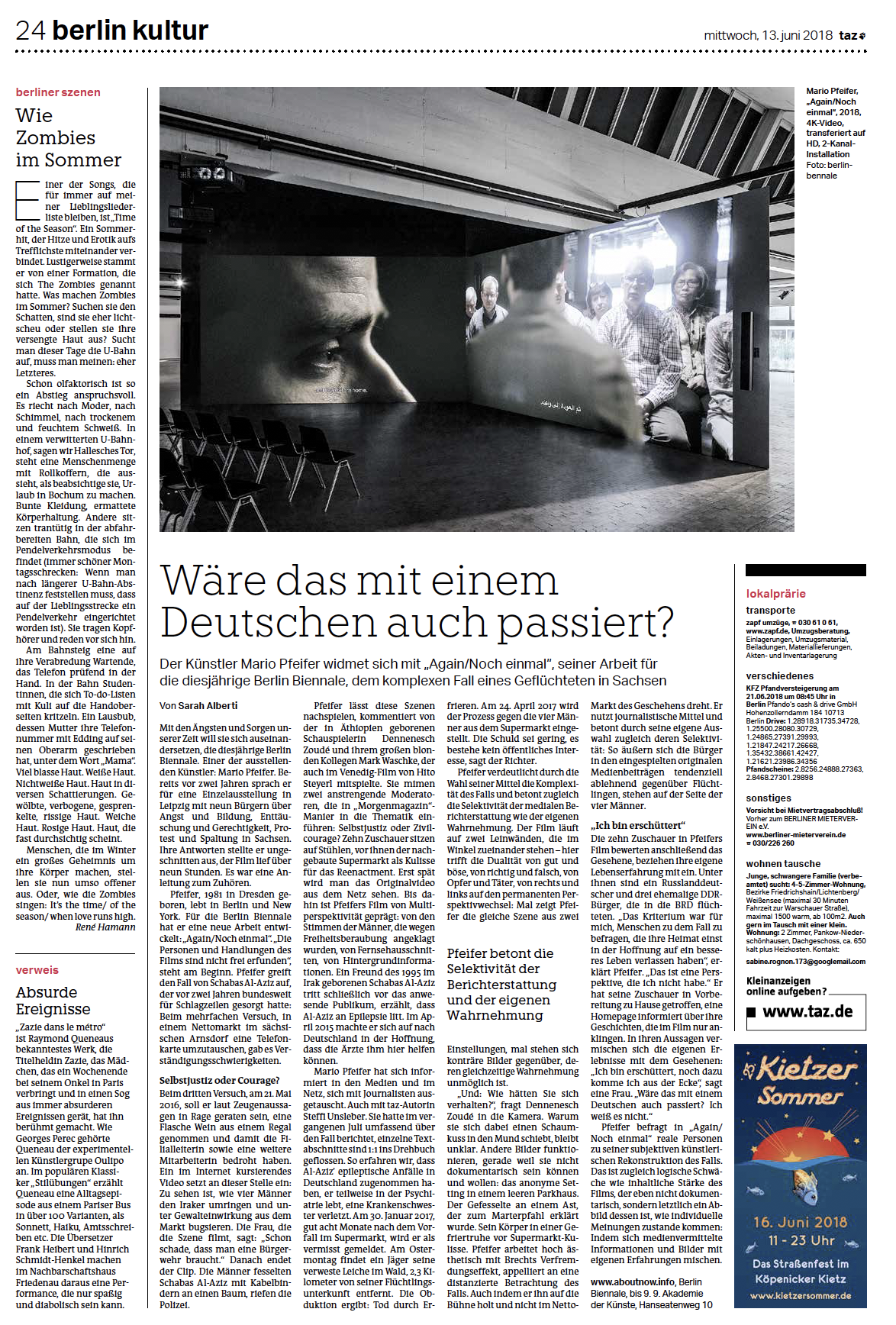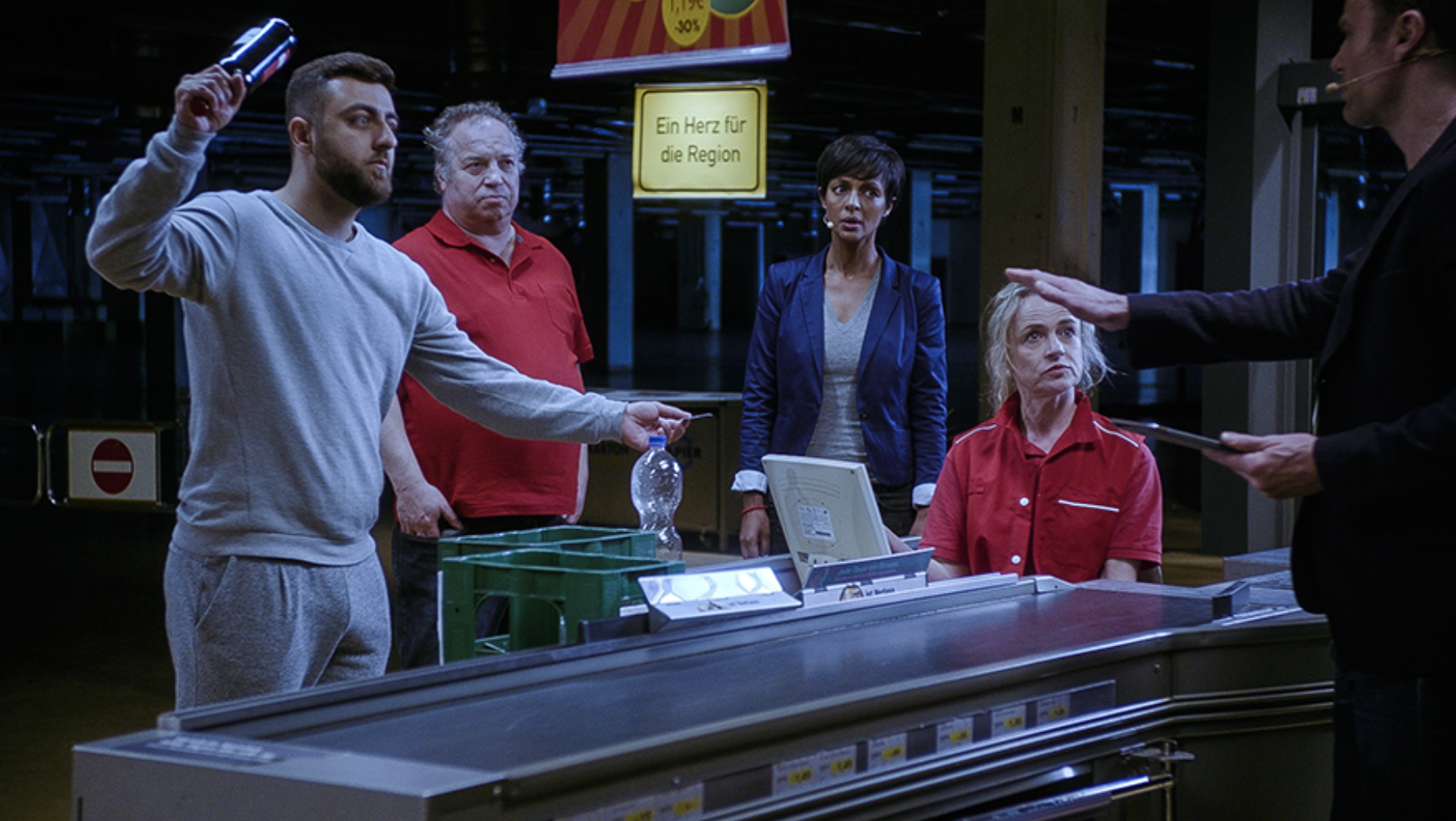The 10 Absolute Best Works of Art We Saw
Around the World in 2018
There’s a lot of art out there. A lot of it is notable in the moment, but doesn’t necessarily stick in the mind. Then there’s that show—or that individual work—you can’t forget. Below, our editors pick the most memorable, exciting, and enchanting art they saw this year.
In 2016, German “vigilantes” beat and dragged an Iraqi refugee out of a grocery store and tied him to a tree. News of the incident, which went viral, was quickly dismissed by the courts and the refugee went missing and later died. In Mario Pfeifer’s two-channel video, which debuted at the Berlin Biennial this summer, the East Germany-born artist reconstructs the situation and creates a false trial to reexamine the incident with a jury of real German citizens. Their conclusions and remarks on the nuances of the migrant experience in Germany are harrowing and profound as we see, more and more, history repeating itself. It is rare that an artwork goes a full step beyond the boundaries of the art-world bubble and takes a real stake in the world. This one did.
—Kate Brown
Selected Press Reviews
The German artist Mario Pfeifer’s video installation “Again” casts a bitter eye on Germany’s refugee crisis.CreditGordon Welters for The New York Times
June 18, 2018
Mario Pfeifer’s Again / Noch einmal (2018) examines one of Germany’s recent wounds - a court case that revealed Germany’s pervasive, underlying xenophobia towards migrants.
Pfeifer uses the conceit of two strangers - an attractive, tall, slim black woman, and a white German man - meeting at the checkout till. In an attempt to initiate conversation, the man asks the woman: “Where are you from?”
Again / Noch einmal shows us that layers, enrichments, complications to one’s identity may mean that one’s life is expendable, and one’s execution an inconvenience to be erased by blaming the complexity itself - rather than the refusal to read it.
– M Neelika Jayawardane
Read the full article here.
august,02 2018
Which does not imply that what is shown is apolitical. Many of the works have political intentions and are perceived as such. But it’s symptomatic that the two most visible artworks motivated by racially grounded discrimination and violence are documentary-style videos by artists from Germany. In Natasha A. Kelly’s Milli’s Awakening (2018), Afro-German women discuss daily racism in their lives and their emancipation from it. Mario Pfeifer’s dual-channel video Again/Noch einmal (2018) re-enacts a court case related to racially motivated violence in a German province. In contrast, the greater part of the works by African, Asian and Latin American artists, many of them women, were, I believe, selected to express the artists’ right to be free to work as they damn well please without being boxed in by duties to represent an identity or a cause.
– Susanne von Falkenhausen
Read the full article here.
august,02 2018
One of the most talked-about works of the Biennale, Mario Pfeifer’s chilling two-channel video installation, “Again / Noch einmal” (2018), reconstructs a recent case of xenophobic violence in Germany.
Pfeifer’s video presents the grizzly details of this case via footage of various reenactments. At one point in the film, a group of Germans are asked to judge the actions of the perpetrators. “Nothing has changed,” one says, in what I saw as a foreboding reference to the Holocaust. The film offers a grim reminder that, for many in today’s Germany, “Refugees Welcome” is an empty promise.
– Dorian Batycka
Read the full article here.
June 08, 2018
The most immediate work is the film AGAIN by Mario Pfeifer, in which the mistreatment of an Iraqi in an Arnsdorf supermarket in April 2016 is the subject of a theatrical chamber piece about vigilante justice and civil courage. Again and again, a black actress asks the protagonists of a jury composed of Germans with a migrant background: What is morally right? Why was the trial against the perpetrators stopped? What had happened?
– Catrin Lorch
Read the full article here.
June 08, 2018
Pfeifer’s work raises questions overlooked by the court, regarding the violence he suffered, and that no one in the system was ever held accountable for the man’s death. The strength of the work ... [is] in the series of interviews with German citizens, most of whom have themselves immigrated to East Germany in the 1990s. Presented with the details of the events, they unanimously conclude that the assault and the man’s death give testimony to German xenophobia and racism.
– Hili Perlson
Read the full article here.
October 04, 2018
Darum geht es Pfeifer, der sich einen humanis-tischen Optimismus bewahrt hat, der auch dort an die Möglichkeit des Dialogs glaubt, wo andere längst resigniert haben. Darum wünscht er sich in jedem Museum einen Raum für aktuelle politische Kunst, eine, die schnell reagiert und den vielen fiebrigen Pseudodiskursen unserer Gegenwart die Faktoren Zeit und Kontemplation entgegenstellt, so wie sein „Again / Noch einmal“, das seinen Anspruch bereits im Titel andeutet: Hier will jemand etwas nicht auf sich beruhen lassen. In dem 42-minütigen Film hebt Pfeifer die Vorgänge in Arnsdorf aus der Sphäre der Gerüchteküchen und Internet-Wackelbilder auf eine ästhetisch ausgeleuchtete Bühne. In einem Parkhaus stellte er die Ereignisse nach. Es ist ein Spiel im Spiel, ein aufwendig recherchiertes Theaterstück. Die bekannten Schauspieler Dennenesch Zoudé und Mark Waschke geben darin gewissermaßen zwei Moderatoren, die das Geschehen immer wieder anhalten, verschiedene Alternativen durchspielen und die Generalfrage stellen: „Zivilcourage oder Selbstjustiz? Lass uns noch mal anschauen. Alles auf Anfang.“
– Jürgen Kleindienst
June 13, 2018
Mr. Pfeifer bracingly stages an all-strings attached re-enactment — his fictional version fuses Brechtian alienation techniques with the showmanship of trashy German talk shows — to pick at both the alleged crime and the holes in its media representation.
– Jason Farago
Read the full article here.
Mario Pfeifer's Again / Noch einmal (2018), a two-channel video installation commissioned for the Biennale, examines one of Germany's recent wounds, writes Jayawardane [Courtesy of Mario Pfeifer/ photo: Timo Ohler]
October Issue, 2018
In Noch einmal (Again), 2018, Mario Pfeifer reconstructed a vigilante attack that took place in a German supermarket in May 2016, when a group of white men seized an epileptic refugee and bound him to a tree with cable ties. The victim, Schabas Al-Aziz, later ran into a forest and died of exposure. The case was dismissed within four hours; the defense deemed that the assailants had acted with “civil courage.” Pfeifer restages the attack with the hokey acting of popular German crime shows in front of an assembled jury. His main asset is the time he takes to tell his story. Forty-two minutes of step-by-step accounting gradually magnify the scale of the injustice. The sincere and moving responses by the jury further underscore the import of the crime. One woman, herself a German immigrant, tells the camera, “The faces of these men instill me with fear.”
– Madeleine Schwartz
Read the full article here.
august,28 2018
Commissioned by the Biennale, Pfeifer collaborated with Rundfunk Berlin-Brandenburg, German state-funded television, to produce a chillingly professional combination of crime television tropes, dramatic reenactments, Brechtian alienation techniques, and documentary footage, all put toward recounting the death of a 21-year-old, mentally ill Iraqi man in Arnsdorf, Saxony, near Dresden. During the Biennale’s opening days, viewers of the piece were visibly shaken; some cried.
– Ana Finel Honigmann
Read the full article here.
Mario Pfeifer, Again / Noch einmal (2018)
OCTOBER 02, 2018
In the film, Pfeifer brings together a jury of people to watch the events unfold, and to witness how it's treated in the media and by the town. The jury members, not actors, but real people who've been confronted with their own experiences of racism in Germany, are often brought to tears. The shock, condemnation and horror that did not register at the time of the event in German media and society is unanimous and strong within the group portrayed in the film. "Would it have happened with a German?" asks one jury member. "I'm not sure," One says she has lost faith in the courts. "I am devastated," says another tearfully.
– Pacinthe Mattar
Read the full article here.
June 13,2018
Pfeifer lässt diese Szenen nachspielen, kommentiert von der in Äthiopien geborenen Schauspielerin Dennenesch Zoudé und ihrem großen blonden Kollegen Mark Waschke.
Sie mimen zwei anstrengende Moderatoren, die in „Morgenmagazin“-Manier in die Thematik einführen: Selbstjustiz oder Zivilcourage? Zehn Zuschauer sitzen auf Stühlen, vor ihnen der nachgebaute Supermarkt als Kulisse für das Reenactment.
Pfeifer verdeutlicht durch die Wahl seiner Mittel die Komplexität des Falls und betont zugleich die Selektivität der medialen Berichterstattung wie der eigenen Wahrnehmung. Der Film läuft auf zwei Leinwänden, die im Winkel zueinander stehen – hier trifft die Dualität von gut und böse, von richtig und falsch, von Opfer und Täter, von rechts und links auf den permanenten Perspektivwechsel: Mal zeigt Pfeifer die gleiche Szene aus zwei Einstellungen, mal stehen sich konträre Bilder gegenüber, deren gleichzeitige Wahrnehmung unmöglich ist.
– Sarah Alberti
Read the full article here.
June 08, 2018
In seinem Film "Again" spielt Mario Pfeifer einen Vorfall im sächsischen Arnsdorf noch einmal durch,bei dem Anwohner einen Asylsuchenden mit Kabelbindern fesselten, weil sie ihn für gewalttätig hielten."Der ist sehr auffällig gewesen auch mit seinem Auftreten, das war schon relativ aggressiv, man weiß ja nie, springt der jetzt auf, tritt einen oder beißt einen", sagen Arnsdorfer im Film.
Mario Pfeifer hakt beharrlich nach, das Faszinierende an dem Reenactement: Es gibt keine Eindeutigkeiten.
– Simone Reber
Read the full article here.
October 04, 2018
Eine Antwort auf die Frage, wer denn „wir (alle)“, wer dieses „Volk“ ist, liefern das Museum jetzt mit Videoarbeiten des Künstlers Mario Pfeifer. „Again/Noch einmal“, für die Berlin Biennale dieses Jahres produziert, greift einen Vorfall aus dem Jahr 2016 im sächsischen Arnsdorf auf, bei dem ein Geflüchteter von vier deutschen Männern nach einem Streit im Supermarkt an einen Baum gefesselt wurde. Der Fall wurde nicht vor Gericht verhandelt, da der Geflüchtete, der offensichtlich an Epilepsie litt, in der Zwischenzeit tragisch verstarb und das Gericht kein öffentliches Interesse an einer Strafverfolgung der Männer sah. Pfeifer rekonstruiert mithilfe von Journalisten den Vorfall und lädt zehn Bürgerinnen und Bürger mit unterschiedlichen Flucht- und Migrations-erfahrungen ein, anschließend ihre Sicht auf den Vorfall zu erläutern. Auch die Betrachter der 42- minütigen Videoinstallation sind aufgefordert, sich ein Urteil darüber zu bilden, welche ethischen Normen wir leben wollen – und wo die Grenzen zwischen Notwehr, Zivilcourage und Selbstjustiz verlaufen.
– Matthias Zwarg














![Mario Pfeifer's Again / Noch einmal (2018), a two-channel video installation commissioned for the Biennale, examines one of Germany's recent wounds, writes Jayawardane [Courtesy of Mario Pfeifer/ photo: Timo Ohler]](https://images.squarespace-cdn.com/content/v1/5afbe87a5ffd20cbdc75a184/1533585358070-VUYVR3VIG4LEAKFTZKCR/Screen+Shot+2018-08-06+at+10.42.19.png)







